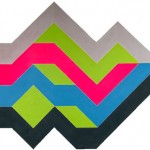52 East 76th Street
New York, NY 10021
T 212.439.6425
Katherine@borghi.org
Blurred Lines
December 15, 2016– February 15, 2017
-

Neil Williams (1934-1988) Pop, 1966
THE WALL IS THE FLOOR: THE SHAPED CANVAS / WALL SCULPTURE
The Wall is the Floor: The Shaped Canvas / Wall Sculpture takes a contemporary look at the pioneers of shaped canvas and untraditional wall sculpture. Frank Stella, Sydney Butchkes, Neil Williams, and John Chamberlain were friends on the East End of Long Island and in New York City – who routinely found each other visiting each others studios, and had great influence on each others work. The shaped canvas and expressive yet geometric wall sculpture blurred the line between painting and object. These artists were designers and craftsmen who took pains to further abolish the tradition of the two dimensional painting, and brought geometric constructivism into a new dimension.
Famous for saying of his artwork: “What you see is what you get.” The sentence became the mantra of minimalist artists of the 1960’s and established Stella as one of the pioneers of a new art movement that stressed the reduction of the image to its most basic elements of color, shape and design. Minimalists strove to create artwork that was devoid of symbolism, representation or opinion. However, the complexity of Stella’s work since the 1960’s casts a shadow of doubt over whether he was able to confine his subjects to the ideas he propagated. This artist’s love of the art history and international culture provided too tempting for him to continue creating within a minimalist philosophy. Unlike other minimalists such as Ellsworth Kelly, Barnett Newman and Ad Reinhardt who acted in reaction to Expressionism, Stella’s work became more painterly and demonstrative as it matured.
For Butchkes, art became a passion early, and he attended the Art Academy of Cincinnati and, in Manhattan, the Art Students League and the New School for Social Research before enlisting to fight in World War II. He was stationed in Europe as a member of the Camouflage Corp and helped devise three-dimensional topographical elevations from maps. His unit also built a facsimile of an important bridge over the Rhine as a decoy for enemy fire.
Back in New York, he worked as a designer at Columbia Records and also designed book jackets while working on his art, eventually devoting all of his time to it. Although his work was initially two-dimensional, mostly paintings in oil and acrylic, he began incorporating sculpture, first separately and then as elaborately constructed frames over which he would stretch canvas. The paintings became objects and blurred the strict lines of formalism that were so central to midcentury art.
An important exponent of Minimal and Systemic painting, Neil Williams (1934-1988) was born in Bluff, Utah, in 1934. He undertook his formal training at the California School of Fine Arts, receiving a Bachelor of Fine Arts degree in 1959. One of the first American artists to investigate the aesthetic potential of the irregularly shaped canvas, Neil Williams initially depicted hard-edged geometric forms, but eventually turned to a painterly abstract style.
Williams began exhibiting his work in New York City in 1960 and continued to do so throughout his career. His first solo show was held at the Green Gallery in Manhattan in 1964. During that same year, he participated in the exhibition, The Shaped Canvas, organized by the Solomon R. Guggenheim Museum, where his work hung alongside that of artists such as Frank Stella and Paul Feeley. In the ensuing years, Williams’s paintings appeared in a number of group shows devoted to advanced trends in American art, including Systemic Painting, curated by Lawrence Alloway and held at the Guggenheim in 1966. He also had one-man exhibitions at the André Emmerich Gallery in New York and the Dwan Gallery in Los Angeles.
Although Neil Williams exhibited regularly in New York and could often be seen at the legendary Max’s Kansas City, he gradually distanced himself from the downtown art scene, spending the majority of his time in Sagaponack, New York, where he shared a studio with Frank Stella.
Born April 16, 1927, in Rochester, Indiana, Chamberlain grew up in Chicago and, after serving in the navy from 1943 to 1946, attended the Art Institute of Chicago from 1951 to 1952. At that time, he began making flat, welded sculpture, influenced by the work of David Smith. In 1955 and 1956, Chamberlain studied and taught sculpture at Black Mountain College, near Asheville, North Carolina, where most of his friends were poets, among them Robert Creeley, Robert Duncan, and Charles Olson. By 1957, he began to include scrap metal from cars in his work, and from 1959 onward he concentrated on sculpture built entirely of crushed automobile parts welded together. Chamberlain’s first major solo show was held at the Martha Jackson Gallery, New York, in 1960.
Chamberlain’s work was widely acclaimed in the early 1960s. His sculpture was included in The Art of Assemblage at the Museum of Modern Art, New York, in 1961, and the same year he participated in the S�o Paulo Bienal. From 1962, Chamberlain showed frequently at the Leo Castelli Gallery, New York, and in 1964 his work was exhibited at the Venice Biennale. While he continued to make sculpture from auto parts, Chamberlain also experimented with other mediums. From 1963 to 1965, he made geometric paintings with sprayed automobile paint. In 1966, the same year he received the first of two fellowships from the John Simon Guggenheim Memorial Foundation, he began a series of sculptures of rolled, folded, and tied urethane foam. These were followed in 1970 by sculptures of melted or crushed metal and heat-crumpled Plexiglas. Chamberlain’s work was presented in a retrospective at the Solomon R. Guggenheim Museum, New York, in 1971.
